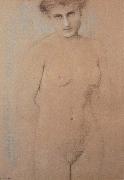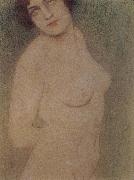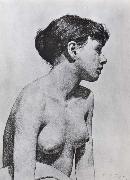Wholesale Oil Painting No Minimum |
|||||||||||
|
|
|||||||||||

|
|||||||||||
|
|
|
||||||||
Fernand Khnopff1858-1921 Belgian Fernand Khnopff Gallery Fernand Khnopff was born to a wealthy family that was part of the high bourgeoisie for generations. Khnopff's ancestors had lived in Flanders since the early 17th-century but were of Austrian and Portuguese descent. Most male members of his family had been lawyers or judges, and young Fernand was destined for a juridical career. In his early childhood (1859-1864) he lived in Bruges where his father was appointed Substitut Du Procureur Du Roi. His childhood memories of the medieval city of Bruges would play a significant role in his later work. In 1864 the family moved to Brussels. To please his parents he went to law school at the Free University of Brussels (now divided into the Universite Libre de Bruxelles and the Vrije Universiteit Brussel) when he was 18 years old. During this period he developed a passion for literature, discovering the works of Baudelaire, Flaubert, Leconte de Lisle and other mostly French authors. With his younger brother Georges Khnopff - also a passionate amateur of contemporary music and poetry - he started to frequent Jeune Belgique ("Young Belgium"), a group of young writers including Max Waller, Georges Rodenbach, Iwan Gilkin and Emile Verhaeren. Khnopff left University due to a lack of interest in his law studies and began to frequent the studio of Xavier Mellery, who made him familiar with the art of painting. On the 25th of October 1876 he enrolled for the Cours De Dessin Apres Nature ("course of drawing after nature") at the Academie Royale des Beaux-Arts en Bruxelles. At the Academie, his most famous fellow student was James Ensor, whom he disliked from the start. Between 1877 and 1880 Khnopff made several trips to Paris where he discovered the work of Delacroix, Ingres, Moreau and Stevens. At the Paris World Fair of 1878 he became acquainted with the oeuvre of Millais and Burne-Jones. During his last year at the Acad??mie in 1878-1879 he neglected his classes in Brussels and lived for a while in Passy, were he visited the Cours Libres of Jules Joseph Lefebvre at the Acad??mie Julian. |
||||||||
|
|
||||||||
Nude Study
Nude Study Painting ID:: 34962 |
mk98
c.1910
Pastel on paper
28.6x19
mk98 c.1910 Pastel on paper 28.6x19 |
|||||||
|
|
||||||||
Fernand Khnopff1858-1921 Belgian Fernand Khnopff Gallery Fernand Khnopff was born to a wealthy family that was part of the high bourgeoisie for generations. Khnopff's ancestors had lived in Flanders since the early 17th-century but were of Austrian and Portuguese descent. Most male members of his family had been lawyers or judges, and young Fernand was destined for a juridical career. In his early childhood (1859-1864) he lived in Bruges where his father was appointed Substitut Du Procureur Du Roi. His childhood memories of the medieval city of Bruges would play a significant role in his later work. In 1864 the family moved to Brussels. To please his parents he went to law school at the Free University of Brussels (now divided into the Universite Libre de Bruxelles and the Vrije Universiteit Brussel) when he was 18 years old. During this period he developed a passion for literature, discovering the works of Baudelaire, Flaubert, Leconte de Lisle and other mostly French authors. With his younger brother Georges Khnopff - also a passionate amateur of contemporary music and poetry - he started to frequent Jeune Belgique ("Young Belgium"), a group of young writers including Max Waller, Georges Rodenbach, Iwan Gilkin and Emile Verhaeren. Khnopff left University due to a lack of interest in his law studies and began to frequent the studio of Xavier Mellery, who made him familiar with the art of painting. On the 25th of October 1876 he enrolled for the Cours De Dessin Apres Nature ("course of drawing after nature") at the Academie Royale des Beaux-Arts en Bruxelles. At the Academie, his most famous fellow student was James Ensor, whom he disliked from the start. Between 1877 and 1880 Khnopff made several trips to Paris where he discovered the work of Delacroix, Ingres, Moreau and Stevens. At the Paris World Fair of 1878 he became acquainted with the oeuvre of Millais and Burne-Jones. During his last year at the Acad??mie in 1878-1879 he neglected his classes in Brussels and lived for a while in Passy, were he visited the Cours Libres of Jules Joseph Lefebvre at the Acad??mie Julian. |
||||||||
|
|
||||||||
|
|
Nude Study
Nude Study Painting ID:: 34964 |
mk98
c.1910
Coloured pencil on paper
20x14.6
mk98 c.1910 Coloured pencil on paper 20x14.6 |
||||||
|
|
||||||||
Frederick MccubbinAustralian Painter, 1855-1917 By the early 1880s, his work began to attract considerable attention and won a number of prizes from the National Gallery, including a 30-pound first prize in 1883 in their annual student exhibition, and by the mid-1880s began to concentrate more on the works of the Australian bush which made him most famous. In 1883, he received first prize in the first annual Gallery students' exhibition, for best studies in colour and drawing. In 1888, he became instructor and master of the School of Design at the National Gallery. In this position he taught a number of students who themselves became prominent Australian artists, including Charles Conder and Arthur Streeton. He continued to paint through the first two decades of the 20th century, though by the beginning of World War I his health began to fail. He travelled to England in 1907 and visited Tasmania, but aside from these relatively short excursions lived most of his life in Melbourne. McCubbin married Annie Moriarty in March, 1889. They had seven children, of whom their son Louis also became an artist. In 1901 McCubbin and his family moved to Mount Macedon, where he was inspired by the surrounding bush and has experimented with the light and its effects on colour in nature. In 1912, |
||||||||
|
|
||||||||
|
|
Nude Study
Nude Study Painting ID:: 42152 |
mk167
c.1910
Oil
mk167 c.1910 Oil |
||||||
|
|
||||||||
E.Phillips FoxAustralian Naturalist Painter, 1865-1915 Australian painter and teacher. From 1878 to 1886 he trained at the National Gallery of Victoria Art Schools, Melbourne, and in 1887 left to study in Europe. In Paris he attended the Academie Julian and was taught by Jean-Leon Gereme at the Ecole des Beaux-Arts and by the American artist T. Alexander Harrison (1853-1930). He was involved with the plein-air artists at Etaples, Pas-de-Calais, and in Brittany and also visited Giverny, where from 1883 Monet was living. By 1890 he had moved to England, to the artists' colony at St Ives, Cornwall. In 1892 he returned to Melbourne where he chiefly painted portraits and landscapes. He was a member of the Victorian Artists' Society, exhibiting with them between 1892 and 1900. In 1893 he established the lively Melbourne Art School with Tudor St George Tucker (1862-1906). There an academic training coupled with a modified Impressionist technique was taught, as can be seen in Fox's painting the Art Students . In 1901 he left for London, having been commissioned by the Trustees of the National Gallery of Victoria to paint the Landing of Captain Cook at Botany Bay. After his marriage in 1905 to the artist Ethel Carrick, he and his wife settled in Paris and remained there until 1913. |
||||||||
|
|
||||||||
|
|
Nude Study
Nude Study Painting ID:: 42175 |
mk167
1884
Charcoal
mk167 1884 Charcoal |
||||||
|
|
||||||||
|
E.Phillips Fox Australian Naturalist Painter, 1865-1915 Australian painter and teacher. From 1878 to 1886 he trained at the National Gallery of Victoria Art Schools, Melbourne, and in 1887 left to study in Europe. In Paris he attended the Academie Julian and was taught by Jean-Leon Gereme at the Ecole des Beaux-Arts and by the American artist T. Alexander Harrison (1853-1930). He was involved with the plein-air artists at Etaples, Pas-de-Calais, and in Brittany and also visited Giverny, where from 1883 Monet was living. By 1890 he had moved to England, to the artists' colony at St Ives, Cornwall. In 1892 he returned to Melbourne where he chiefly painted portraits and landscapes. He was a member of the Victorian Artists' Society, exhibiting with them between 1892 and 1900. In 1893 he established the lively Melbourne Art School with Tudor St George Tucker (1862-1906). There an academic training coupled with a modified Impressionist technique was taught, as can be seen in Fox's painting the Art Students . In 1901 he left for London, having been commissioned by the Trustees of the National Gallery of Victoria to paint the Landing of Captain Cook at Botany Bay. After his marriage in 1905 to the artist Ethel Carrick, he and his wife settled in Paris and remained there until 1913. Nude Study mk167 1884 Charcoal |
||||||||
|
|
||||||||
|
Prev Next
|
||||||||
|
|
||||||||
|
Related Paintings to E.Phillips Fox :. |
||||||||
|
|
||||||||
|
CONTACT US |




